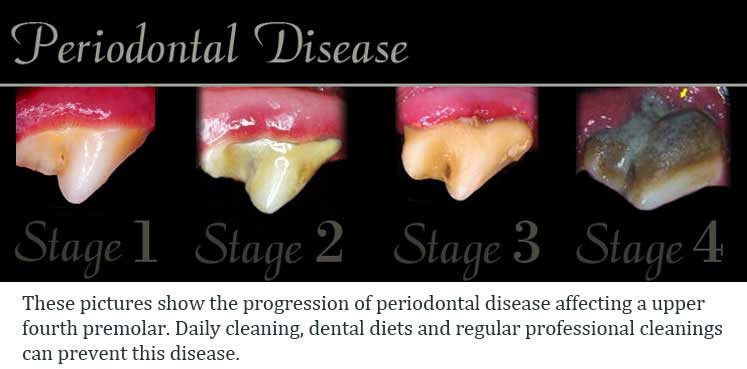Periodontal is an infection and inflammation of the supporting structures that is the gums of the teeth, alveolar bone and periodontal ligament. Extremely common in dogs and invades like a silent killer with almost nonexistent symptoms in the beginning. Infamous for causing deadly pain, tooth & bone loss, erosion of the gums, all in all wrecks havoc in your pet pooches’ mouth. But the good news is that it can be prevented. It is more prevalent in senior canines; another fact associated with this gum disease is that it affects dogs five times more compared to humans. As a dog owner how often do you brush your dog’s teeth? Perhaps not that regularly; this leads to excessive plaque formation as the bacteria responsible for it easily multiplies in the absence of oral hygiene. Also canines have a much more alkaline mouth compared to human beings that is why they are more prone to plaque formation. The two kinds of bacteria that cause gum disease in dogs are Actinomyces and Streptococcus.
Brett Beckman a practicing dentist in Florida and Georgia highlights the severity of Periodontal by explaining its grave repercussions. One being, Jaw fracture, advanced periodontal can damage the bone to a level that even a little pressure can break the weakened jawbone. Colleen O’Morrow a veterinary dentist in Canada & fellow of the Academy of veterinary dentistry has explained the issues related to periodontal beyond tooth pain; advanced gum disease in canines may put the dog at a greater risk of cardiac disorders and illnesses of the kidney and liver.
The earliest stage of Periodontal
Gingivitis is the initial stage of the disease, involving a bacterial infection of the gums. Let’s delve deeply into what happens after your pet dog consumes edibles. The bacteria accompanied by particles of food begin to accumulate plague on the teeth. This combines with the drool and minerals to form calculus that is responsible for inflammation and reddening of the gums often termed as gingivitis. In this phase there is no separation of the gum from the tooth.
Cure of gingivitis involves brushing of the teeth every day with prescribed toothpaste followed by cleansing and polishing to curb plague formation. Use of fluoride for effective treatment plays an important role in this stage.
The second stage
It is characterized by the periodontal pockets; the calculus slowly builds below the gums. This leads to a separation between gums and the teeth.
Treatment procedures in this stage involve cleaning the pockets. An antibiotic gel is usually prescribed to reduce the space between the gums and teeth.
The third stage
The periodontal pockets reach deeper than 5 millimeters; bones are now involved unlike in the second stage. Spaces that are formed underneath the teeth aid further in growth of bacteria leading to bone loss, tissue damage around the roots of the teeth and formation of pus in between the teeth and gums.
Treatment in this stage is similar to the steps followed in the second stage. The aim is to revive the periodontal tissues with the use of antibiotic gel.
The fourth stage
It is characterized by irreversible damage where extracting the tooth is the only option as bone loss reaches more than 50 percent. This stage is also called advanced periodontists, in which the roots of the teeth get visible due to the diminishing of the gum tissue.
Processes such as bone replacement, periodontal splinting that is the joining of teeth using fixed or detachable devices and tissue renewal.
Preventive Measures that can save dogs from the painful periodontal disease
Simple daily brushing for a healthy mouth and strong set of pearly whites: Consult your veterinarian for effective guidance and the right set of implements to make smooth the whole procedure. ‘’Pets’ teeth should be brushed twice daily just like humans’ teeth’’, opines Canadian vet dentist O’Morrow.
Regular Oral Checkups: Dental X-rays are very important in revealing the extent of periodontal disease. X-rays are carried under common anesthesia. They help in diagnosing symptoms that are buried below the gum line.
Feed superior food to your dog: Certain foods prevent the solidifying of plague and also in some cases prevention of it by rubbing off the teeth during the chewing & grinding process. A dog parent can purchase dental chews for in interesting flavors, oral care sticks, calcium milk dental dog chews to name a few.
Similarly toys such as dental play ring, rubber chew balls with rope tug and stick dog toys can be incorporated in your pooch’s play time to provide dental hygiene along with necessary overall stimulation.
Pet owners can consult the vet for the ideal `dental diet’ and suitable supplements for dogs in accordance with the type of breed.
Your pet’s healthcare regime, most definitely should include proper dental care and regular checkups to maintain oral health. Partner with the animal-doctor to ensure your beloved’s overall well being.

